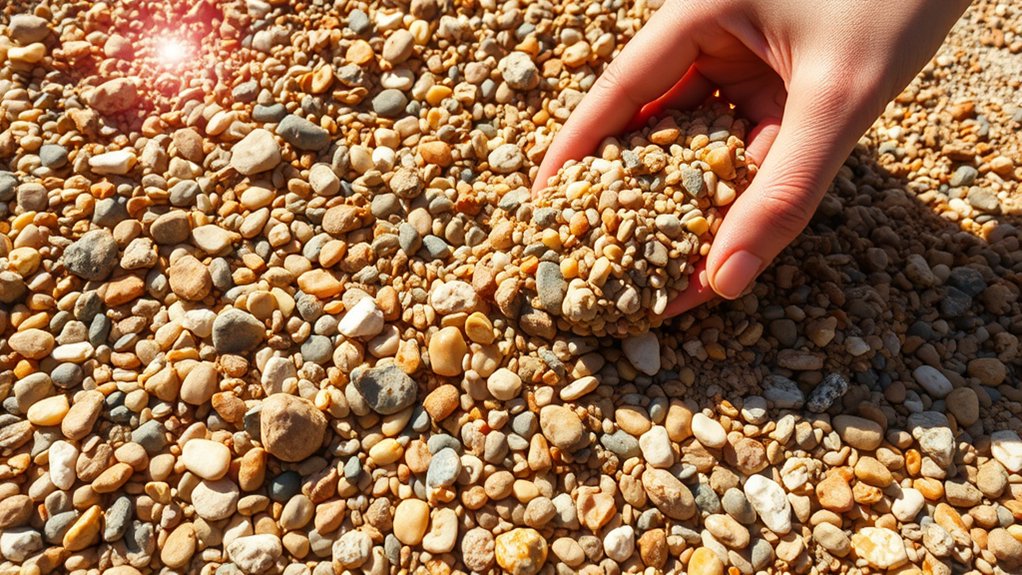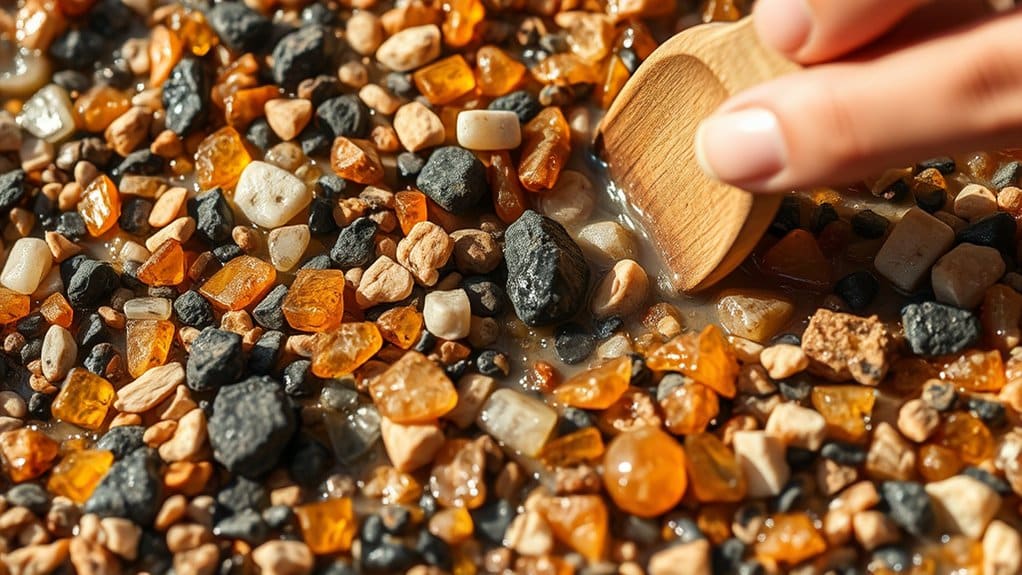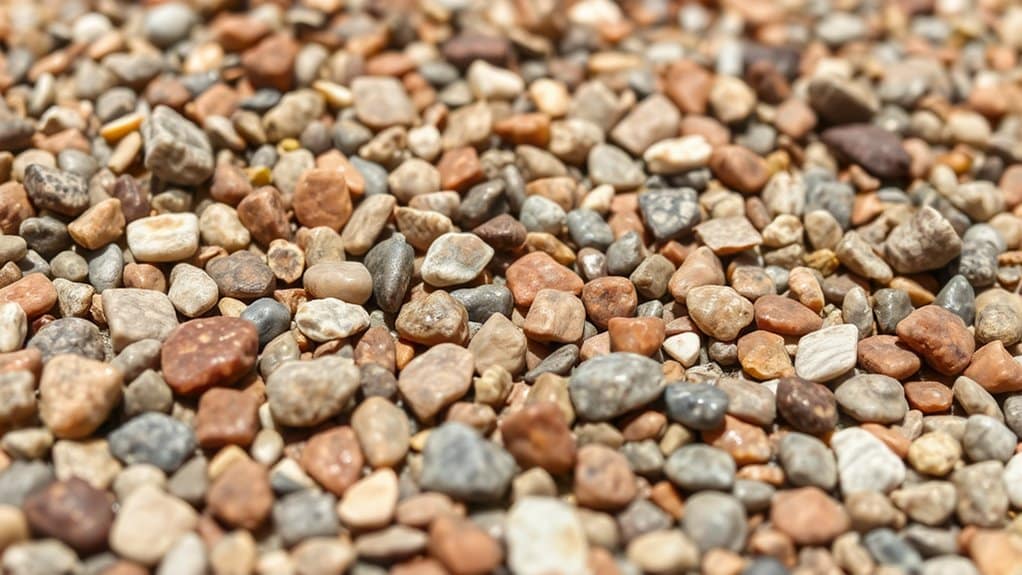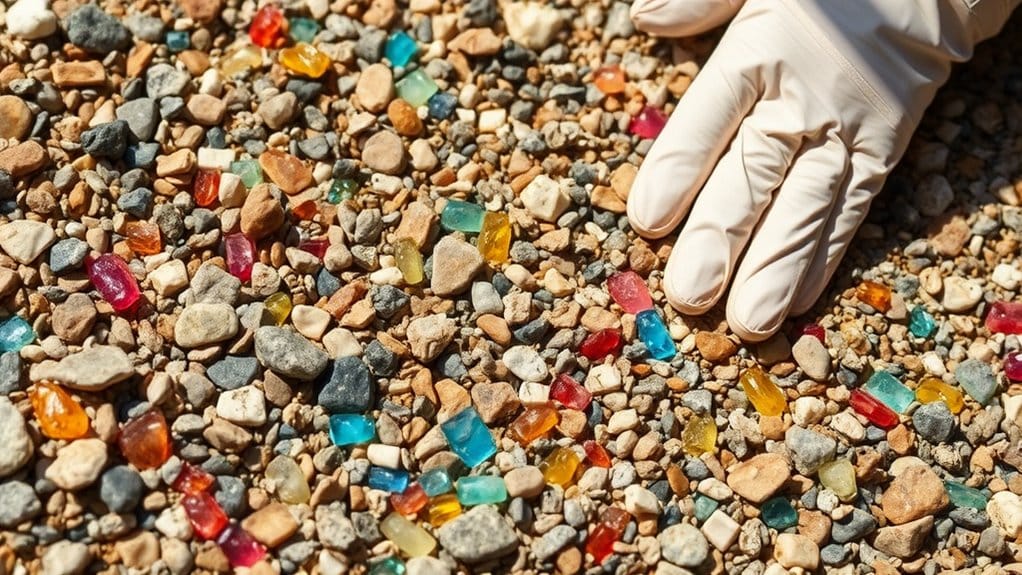Absolutely – mixing different aggregates in resin-bound gravel works brilliantly. The blend creates a stronger, longer-lasting surface with distinctive visual appeal. Combining sizes (say 2-5mm with 1-3mm) delivers better grip, particularly useful for British weather conditions. The mix also helps with drainage and cuts down on resin usage, saving you money. Most UK installers recommend a blend of aggregates for optimal results, particularly for driveways and garden paths where durability matters most.
Key Takeaways
Mixing different aggregates in resin-bound gravel is a smart choice for British driveways and paths. The blend creates a stronger, more attractive surface whilst keeping costs down.
Combining smaller stones (1-3mm) with larger ones (2-5mm) delivers two key benefits: improved strength and reduced resin usage. The varied sizes lock together naturally, creating a more stable surface that's less likely to crack or shift.
Mixed surfaces provide better grip in our notoriously wet British weather, with fewer loose stones to worry about. This makes them particularly suitable for driveways, paths and public spaces.
The blended approach ensures excellent drainage, meeting current SUDs regulations for sustainable drainage – crucial for preventing flooding in UK gardens and developments.
When properly mixed, the aggregates create an even spread with minimal gaps, leading to a longer-lasting installation that won't need frequent repairs. The varied colours and textures also help hide dirt and wear, keeping the surface looking fresh for longer.
Understanding Resin-Bound Gravel

Resin-bound gravel combines natural stone with tough synthetic resins, creating a hard-wearing surface that's perfect for British driveways and paths.
The UV-stable resin, commonly epoxy or polyurethane, bonds well with various stones – from standard gravel to decorative aggregates you'd find at any UK builders' merchant. Most installers use stones sized between 1-3mm and 2-5mm, about the size of a small pea, which gives the best balance of strength and looks. This surface is also highly customizable with different colors and textures to suit your aesthetic preferences. Additionally, selecting the right stones based on their material properties can enhance durability and performance.
The process is straightforward: a two-part resin gets mixed with your chosen stones until every piece is properly coated, rather like mixing cake ingredients. This thorough mixing is crucial – it's what ensures your surface will stay solid and smart-looking through typical British weather. Think of it as making a very tough concrete, but with a much more attractive finish.
Benefits of Mixing Aggregates

Mixing aggregates in resin-bound gravel delivers superior strength and longevity, creating a steadfast surface for driveways and paths. The blend of different stones produces a rich, distinctive finish – think of the natural beauty of riverside pebbles with their varied colours and shapes. By combining materials like quartz, marble or recycled glass, you'll achieve both visual appeal and practicality whilst often reducing overall costs. The mixture allows for better surface grip in wet weather and helps prevent loose stones, a common issue with single-aggregate surfaces. Additionally, this blending enhances the permeable surface feature, which prevents stormwater runoff and promotes sustainable landscaping practices. Using a variety of aggregates also ensures compliance with UK SUDs regulations, maintaining effective drainage and minimizing flooding risks.
Enhanced Strength and Durability
Blending different aggregate sizes creates a stronger, more durable resin-bound surface. Mixing 2-5mm and 1-3mm stones lets you use less resin whilst maintaining strength, which cuts costs and improves performance. The varied sizes pack together tightly, making the surface more resistant to cracking and better able to handle both foot traffic and vehicles. Additionally, the mixed aggregates contribute to the surface's excellent drainage properties, which are essential for heavy rainfall areas. This ensures compliance with UK drainage regulations, and the mixed aggregates form a robust structure that stands up well to British weather, from summer heat to winter frost. This means less upkeep is needed, as the surface stays watertight and even. Whether for driveways or garden paths, this method delivers a hardwearing surface that lasts for years.
Improved Aesthetics and Texture
A blend of aggregates boosts both the look and feel of outdoor surfaces. When mixed together, different stones can create colour schemes ranging from natural browns and greys to bold, eye-catching shades.
The mix of stone sizes adds texture, whilst careful selection of materials lets you match your home's style perfectly. You might choose warm honey-coloured stones to complement a Cotswold stone house, or sleek grey granite chips for a modern property.
The flexibility of resin-bound surfaces means you can create unique patterns and finishes – from simple, elegant surfaces to more detailed designs that catch the eye.
The beauty of using varied aggregates lies in their versatility: whether you're after a subtle garden path or a striking driveway, the right combination of stones will help achieve the look you want.
Cost Efficiency and Savings
Cost savings with resin-bound gravel come from smart aggregate blending. Mixing different-sized stones reduces the amount of resin needed, which cuts costs without compromising strength.
Choosing local aggregates helps slash transport expenses – for example, using quarry materials from within your county rather than importing from abroad.
The right mix of aggregate sizes fills gaps more efficiently, much like fitting both large and small boxes in a storage unit. This approach means less material waste and better durability, keeping maintenance costs down over time.
Even distribution of resin throughout the mix prevents wastage – think of it like making sure paint covers a wall uniformly.
This practical approach delivers both quality and value, keeping projects on budget whilst ensuring a lasting finish.
Selecting the Right Aggregate Sizes

Choosing the right aggregate sizes for resin-bound gravel is crucial for both strength and looks. A mix of 1-3mm and 2-5mm stones works best – think of it like making concrete, where different-sized particles lock together properly.
For most domestic driveways and paths, this combination delivers a smart finish whilst ensuring the surface holds up well against daily wear.
Just remember: larger stones create a more rustic look, whilst smaller ones give a smoother, more modern appearance.
Aggregate Size Importance
Choosing the right aggregate sizes makes all the difference in resin-bound gravel surfaces. For most UK projects, aggregates between 1-5mm deliver the best results.
A 15-18mm depth works perfectly for paths and patios with regular foot traffic. Mixing different sizes, such as 1-3mm with 2-5mm, creates a stronger surface whilst using less resin.
It's worth considering local quarry materials – they're often cheaper and better for the environment as they travel shorter distances.
The size you pick affects both how your surface looks and how well it performs over the years.
Strength and Appearance Enhancement
The right aggregate sizes are crucial for both the strength and visual appeal of resin-bound gravel surfaces. Consider these essential factors:
- Mixing Ratios: Use 7-15% resin by weight, adjusting to stone size for optimal strength. For instance, smaller stones typically need more resin to bond effectively.
- Aggregate Compatibility: Mix stone sizes like 2-5mm with 1-3mm for a tight, stable surface that withstands heavy foot traffic and weather.
- Visual Appeal: Combine different aggregates, such as local quartz with marble chips, to create eye-catching patterns and rich textures.
- Customisation: Select varied colours and shapes to match your property's style – grey granite suits modern homes, whilst golden gravels complement traditional builds.
The Mixing Process Explained

The Mixing Process for Resin-Bound Gravel
Getting the mix right is crucial for a lasting, professional finish. Use a forced action mixer and ensure proper aggregate compatibility throughout.
| Step | Action |
|---|---|
| 1 | Check aggregates are clean and thoroughly dried |
| 2 | Blend Part A and Part B of the resin |
| 3 | Add first two bags of aggregate |
| 4 | Mix in remaining aggregates gradually |
| 5 | Look for uniform, glossy coating |
Essential safety kit (PPE) must be worn. Keep mixing times consistent – think of it like making a cake, where proper blending ensures no dry patches. Avoid mixing in wet conditions, as moisture will compromise the final result.
Impact on Surface Texture and Appearance

Impact on Surface Texture and Appearance
Different aggregates shape how resin-bound gravel looks and feels. Choosing the right combination matters for both style and practicality.
Key points to consider:
- Surface Grip: Adding C52 sand helps create a non-slip surface – particularly important for our wet British weather.
- Feel Underfoot: Smaller stones create a smoother finish, whilst larger aggregates offer more texture – rather like the difference between walking on pebbles versus fine gravel.
- Visual Appeal: Mixing aggregate colours can match your garden or driveway scheme. Popular combinations include Cotswold with Yorkshire Cream for a natural look.
- Lasting Quality: The right blend of stone sizes fills gaps properly, preventing loose spots and wear over time.
Application Techniques for Mixed Aggregates

Effective mixing of aggregates is vital for a long-lasting, attractive resin-bound gravel surface. Use a forced action mixer with the right mix ratio – generally 75% of 2-5mm and 25% of 1-3mm gravel. Add resin at 7-15% of total weight and mix for 3-5 minutes until thoroughly coated.
Spread the mixture in a grid pattern using a notched trowel or squeegee, maintaining an 18mm depth throughout. Work in circular motions to achieve a smooth finish, and check levels regularly. Press edges firmly to avoid gaps – much like sealing the crust of a pie – ensuring a neat, complete installation.
This straightforward approach delivers a professional finish that's both practical and visually pleasing. Think of it as laying a carpet – the preparation and technique make all the difference to the end result.
Ensuring Durability and Longevity

Ensuring Durability and Long Life
Quality materials and proper mixing make all the difference in resin-bound gravel surfaces – much like brewing a proper cup of tea, it's all in the preparation:
- Pick premium, washed and kiln-dried stones – clean aggregates bond better, just as clean teacups make better tea.
- Get the mix right – blend different stone sizes for optimal strength, similar to layering stones in a garden wall.
- Mix thoroughly and consistently – each batch should match the last for an even finish.
- Use tough, weather-resistant resin – it needs to handle everything from scorching summer days to winter frost.
Each step matters for a surface that won't crack, fade or break down under British weather.
Think of it as building your garden path to last generations, not just seasons.
Frequently Asked Questions
Can Different Colors of Aggregates Be Mixed Together?
Different coloured aggregates can be mixed together effectively for better visual appeal. Ensure proper mixing and surface preparation to achieve an even colour blend throughout. Common combinations include mixing grey with white for a classic look, or blending earth tones for a natural garden path effect. The key is maintaining consistency across the entire surface for a professional finish.
How Does Aggregate Mixing Affect Installation Time?
Mixing aggregates significantly affects installation speed and efficiency. Poor aggregate matching leads to uneven mixing periods, causing site delays and potential surface defects. Much like baking with incompatible ingredients, mismatched aggregates require constant adjustments, slowing down the entire project. Getting the mix right from the start saves both time and ensures proper surface finish.
Are There Specific Aggregate Combinations That Are Not Recommended?
Poor aggregate combinations can cause serious problems in construction. Mixing very fine particles or using overly wet materials leads to weak spots and uneven surfaces. Best to avoid sand-heavy mixes or water-logged aggregates, as these waste expensive resin and won't give you a solid finished product. For UK builders, this means steering clear of unwashed quarry fines or aggregates stored in damp conditions.
What Is the Maximum Percentage of Different Aggregates Allowed?
The maximum aggregate mix typically allows up to 30% variation between types. When blending aggregates, stick to these limits whilst ensuring your mix delivers the required strength and visual finish. Common UK building projects might combine crushed stone with river gravel, but always check local building regulations for specific requirements.
Can Organic Materials Be Mixed With Aggregates?
Organic materials generally don't mix well with aggregates in resin-bound projects. These materials can break down over time and react poorly with resins, leading to structural issues and an uneven finish. For best results with resin-bound surfaces, such as driveways or garden paths, stick to tested inorganic aggregates like crushed stone, gravel or recycled glass. These materials provide reliable strength and a consistent appearance that lasts.
Conclusion
Mixing different aggregates in resin-bound gravel is entirely possible and practical. Combining various stones, such as rounded pebbles with angular granite chips, creates unique patterns and textures in your driveway or path. The key is to select aggregates of compatible sizes – typically between 1-6mm – to ensure proper binding and a level finish. For example, pairing Thames Valley gravel with crushed marble offers both visual interest and reliable performance. Just ensure all aggregates are clean and dry before mixing to achieve the best results.
